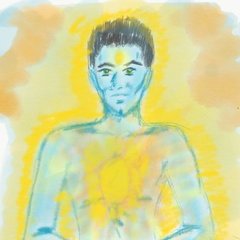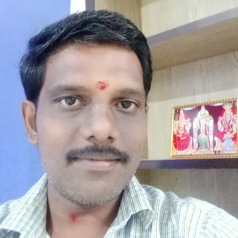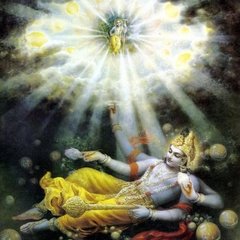Search the Community
Showing results for tags 'advaita'.
Found 72 results
-

Consciousness in Zen Buddhism and how it relates to Vedanta
dwai posted a topic in General Discussion
My spiritual mentor is a venerable spiritual stalwart who was a direct disciple of two jivanamuktas in the Hindu tradition (one being the Shankaracharya of the Sringeri Math), a student of a Zen lineage holder (3rd generation dharma heir of Hsu Yun). He is a most spectacular individual, who somehow took it upon himself to guide me (as to why, is mystifying for me, but I'm not complaining ). Well, he asked me to read a book titled "Zen: The Dawn in the West", by Roshi Philip Kapleau. I've already done some studying of the buddhist sutras and found myself agreeing with everything the Buddha had said anyway. I'm halfway through the book and in it I found the most lucid, pragmatic and no-nonsense directions and advice about meditation and the spiritual approach, that I thought I'd recommend it here. At the same time, I found a beautiful illustration of the model of consciousness according to (Zen) buddhism, which piqued my interest. I have taken that model and added a correlation to the Vedantic model of consciousness (Being actually) which some might find of interest. In the above diagram, the left hand side is from the original book and the right hand side is my addition. It becomes infinitely clear that there is a wonderful overlap between the Buddhist model and the vedantic models. In the buddhist model, the first 6 levels of consciousness map very neatly into the vedantic (and actually samkhya) model of the five tanmatras (associated with the sense functions) and part of the mental apparatuses that identifies with the body (ego). The mind, intellect aspect of the antahkarana seem to correlate with the level 7 (termed manas in the buddhist model) while the chitta aspect (storehouse of impressions) seems to correlate with the 8th level or "relative Alaya consciousness". This also seems to correlate with the causal body (kārana sharira) which is said to contain the karmic seeds (samsakaras) from which spring forth actions and consequences in a cyclical manner. At level 9, is absolute Alaya consciousness, which he labels "Formless Self or True-Nature". This maps very nicely as Atman (Vedantic model). Somethings to ponder for sure. I hope this will lead to "peaceful" explorations of the areas of consensus, which has always been my primary interest. -
In Advaita Vedanta studies, an analogy using the example of clay and pots (made of clay) is often used to illustrate the nature of Turiya and the three "normal" states of consciousness, namely waking, dreaming and deep sleep. The analogy goes like this - This analogy/example has a limited purpose, to illustrate and evoke in the mind of the student the relationship between Turiya/Atman and the three states of waking, dreaming and deep sleep. If taken too far -- for e.g. some worthies might start going into the details of comparing the chemical compositions of the clay, the firing process, the presence of the potter, etc to try and prove that the pots are indeed apart from the clay, it has gone beyond the point of utility of the example. Another example often used is that of Gold and ornaments made of gold. While Turiya is called the "4th state", it really is not a state at all. It is the Reality in which the three states of waking, dreaming and deep sleep rise and fall. That implies that Turiya is always present and available. People have argued as to why then is Turiya called the "4th"? It is done so with the intention of gradually drawing the student's attention from the everyday experiences of waking, dreaming and deep sleep to the ever-present reality of Pure Awareness (aka Turiya). This type of practice is known as "arundhati nyāya or arundhati darśana nyāya" in classical Indian systems, wherein the student's attention is gradually guided from the most obvious to the most subtle (the most subtle being the actual topic of study).
- 20 replies
-
- 3
-

-
- nondualism
- advaita
-
(and 2 more)
Tagged with:
-
I recently had some conversations with one of my spiritual mentors and subsequently one of my spiritual brothers. The topic of being stable in the Self-knowledge came up. Being stable in the Self-knowledge to me means, never losing track of the fact that it is the Self that is witnessing all the drama which unfolds on a daily basis upon the body and the mind. Have a hard day at work or at home or in traffic or ______ (fill the blanks in)? If we get caught up in the issues (and hence suffering), then we are not stable in Self-knowledge. Because being stable means we will not suffer one bit. Even if the occurrences obfuscate our true blissful and unaffected nature for even an instant, in the very next instant the knowledge will pull us out of suffering, like a safety line will pull a bungee jumper out of the river as he/she takes a plunge. Being stable means our peaceful nature is never dependent on or is threatened by any occurrence or event. Our true nature is like the sky, which unaffected by the different shapes, sizes of clouds, winds and storms that blow across it. Similarly, irrespective of samsāra and its processes (good or bad), we are always the unaffected, unafflicted awareness.
-

Non-dual awareness is without attributes. But what about Love?
dwai posted a topic in General Discussion
https://www.medhajournal.com/non-dual-awareness-is-without-attributes-but-what-about-love/ -
-
No matter how auspicious an idea may appear as it is known by a knower from within the mind, identification with being anything in particular is essentially self-imposed limitation. The guru admonishes to leave concepts behind, to relinquish the identity of doership and acting, to be free of burdens not needful which may become to us as obstacles. Being is without doing. One can not help but simply Be oneself. All that must be done is then done rightly and naturally. Simply be as one has been, as one already is and as one will forever be. Be as you are, for the naturalness of this being that we are is that which makes the supposed becoming of anything in particular possible. Being this being, is to naturally abandon this or that identity. In this being, it's revealed that one is the knowing-ness of knowledge, the doing-ness of that which is done; the essence, the very being-ness of being itself. The Power of power. There's no being of this or that, there is only this-ness or that-ness, through and through. The heart of being, which is being, and beyond it. The Paramakash, so far removed from what the mind can imagine, that even the pure consciousness "I AM" seems to be an almost alien thing. From Paramakash, to Mahadakash: The gods and devas may possess names and forms, but the "light" of consciousness is completely attributeless. Without a body, it embodies all. That "light" which illuminates the mind as a reflection, is no more the mind or its contents than the Sun is equal to the daylight it provides. Lord Krishna: "By Me, in My unmanifested form, this entire universe is pervaded. All beings are in Me, but I am not in them. And yet everything that is created does not rest in Me. Behold My mystic opulence! Although I am the maintainer of all living entities and although I am everywhere, I am not a part of this cosmic manifestation, for My Self is the very source of creation." Innumerable states seem to appear upon or within this "light", along with the appearance of one(s) who appear(s) to traverse them. Eternally back and forth, seesawing up and down, the actions and inaction of the apparent many is reflected in the waking dream and deep sleep states. One can get comfortable in a dream of one's own making, lucid even, yet become mesmerized by the powers of awareness in the dream. One can become engrossed in the indulgences of physicality, unsatiated by desires of experiencing waking life to its presumed fullest potential. These states come and these states go. Yet there exists a "state" which never comes and never goes, beyond even the self-love that is undifferentiated bliss experienced in deep sleep. It is all there is. Conscious, unconscious, both conscious and unconscious, and Neither. The original being, experienceless, stateless in its state, in which all states and all experiences appear as if they were themselves dreams of a dreamer unknown.
-
In the text Tripura Rahasya, King Janaka expounds to sage Ashtavakra about the nature of samadhi. He says that nirvikalpa samadhi is a continuous experience of every being. It is only interrupted by thoughts and objects. When the mind is extroverted one doesn’t realize the nirvalkpa samadhi that is constantly there, as the attention is busy grasping this and that. The purification of the mind is with the introverting of the mind, from outside to within. As the mind purifies the samadhi becomes apparent and eventually one can effortlessly stay like that (effortless samadhi).
- 52 replies
-
- 4
-

-

-

You are NOT qualified to critique a Spiritual Tradition if...
dwai posted a topic in Hindu Discussion
Before one criticizes another tradition or tries to posit comparative analyses, the following questions should be taken into consideration. Why are you interested in the differences? You will know, deep in your heart why. Is it to prove X is better than Y? Do you think having a transactional (mercantile) attitude towards spirituality is going to serve you well in the long run? Have you actually learnt in their entirety, the systems that you are comparing? I'll take Advaita Vedanta for instance. Many a sharpshooter has tried to do these type of comparative studies of AV (AV vs This or That). Hold on a second...are you actually qualified to do so? If you want to do justice to your intellect and your spiritual path, you need to first qualify as a student. In Ancient India, there was a healthy tradition of debates between different schools of thought/sprituality. But that required a deep understanding of both positions (that which you are speaking for, and that which you are critiquing). If AV vs "X, Y or Z" is your topic of choice, you need to qualify as a serious student first, before you get the right to criticize it. In order to be considered a serious Advaita Vedantin, the following conditions need apply -- Sādhanā chatustāya - The Four Means What are they? The four means are -- Viveka - The ability to discriminate real from unreal (Real here means that which has independent Self-nature - aka the Self). This at least needs to manifest in the ability to discern what doesn't have independent self-nature (aka phenomena). vairagya - Non-attachment Shadsampat - The six virtues -- Shama - Tranquility of the mind (reducing the modifications of the mind) Dama - Control of the senses uparati - cessation of the need for sensory activities (not craving experiences), implying a sense of contentment titikshā - Fortitude - The ability to persevere with the inquiry/practice. Come what may, I WILL NOT give up until I have full understanding shraddhā - Respect for the tradition, the teachings and it's preceptors. samādhāna - Focus that will allow one to pursue the inquiry Mumukshutva - Burning Thirst for Liberation If you don't have these, then you are not a serious student of Advaita Vedanta. These are the qualities that qualify one to be an Advaita Vedantin (adhikāri). If you haven't done your homework, your comparisons are going to be in vain. Some of the shoddy comparisons I find pertaining to Advaita Vedanta prompted me to write this post. Somethings we should avoid doing is setting up straw man arguments. This is 101 in debates. Otherwise the comparisons/debates become farcical. What constitute straw man arguments? Attributing cherry-picked/out of context, or incomplete facts towards one party of the comparison/debate, or, worse still, half-truths (or half-lies). For instance - "Advaita Vedanta says World is False/illusory". Yes, but when taken in context of the second part of the statement - The World is none other than Brahman who is Absolute Reality, it doesn't seem as shocking or dramatic anymore. Or take for instance the statement - "Advaita Vedanta says that the limited being cannot experience the Universal Being". No where in any upanishads or commentaries of the various Advaita Vedanta masters is that said. Instead, when we study deeper, we find that Advaita Vedanta says the Universal Being (Brahman) appears to the individual being in different forms depending on the state he/she is in (waking, dreaming, deep-sleep). The list can go on and on...but I'll stop here. Hari Om Tat Sat -
That which Awakens is always awake, always there. I attended a 3 day retreat on The Mandukya Upanishad, which shows us the nonduality inherent in our everyday experience, right here and right now, by pointing to something that underlies our everyday experiences of waking, dreaming and deep sleep. To try an exercise as an experiment (I've seen Papaji do this and it worked for me), for anyone who wants to try ie. -- Try and see who you are, in a fraction of a second, without thinking. Don't try to guess what the answer will be, but in YOUR EXPERIENCE, see who you are, without thinking. What do you get? More to follow afterwards.
-
Hi, I am wondering if Advaita vedanta (or Kashmir shavism), the most prominent types of jnana yoga can lead students to the opening of chakras. Some say that just reading, listening or self-enquiry makes it possible to open chakras. Is it really possible? Thanks
-
https://www.medhajournal.com/the-art-of-listening/
- 15 replies
-
- 3
-

-
- spirituality
- advaita
-
(and 1 more)
Tagged with:
-

spiritual enlightenment Spiritual Enlightenment Demystified
Shanmugam posted a topic in General Discussion
A talk about spiritual enlightenment: https://youtu.be/ghsFEVeLbCk This talk discusses the following:1)Why seek Spiritual Enlightenment?2) Hedonic treadmill - A psychological theory which is related to the motivations behind seeking spiritual enlightenment.3) Some misconceptions about spiritual enlightenment.4) How duality or sense of separation is created.and more... -

Sadhana Chatushtaya - Fourfold qualifications in Advaita Vedanta
Shanmugam posted a topic in Hindu Discussion
Sadhana Chatushtaya - Fourfold qualifications for a spiritual seekerhttps://youtu.be/rq8B2_ugwTk -
People are mystified with or annoyed at people who have woken up making statements like “all you need is to be silent/still” or “nothing needs to be done”. For those who have spent years trying to “get something” - energy, grace, etc, is an assumption that they are somehow incomplete and will be fulfilled when they “get some thing”. Years of toiling, practice, austerities, thinking pile on. But mostly there are moments of experiences of “bliss”, a glimpse here, a taste there, and the elusive “awakeness” keeps playing hide and seek! But there really is nothing to “get”. There is a lot to give up though. The reason is simply because there is nothing one gets from the “outside” that wakes you up. In a sense no one really was asleep, so no one wakes up. What goes away is the mistaken identification and sense of bondage. All that is needed is simply that — give up the mistaken notions of bondage and simply trace the culprit back to its source. The culprit is the mind, and the 10,000 things it creates. It seems so hard because it calls for a type of undoing that is counterintuitive. The mind likes to do this and that. It’s job is to solve problems and subdivide one into many. So simply letting it be seems like the hardest thing to do. But all is needed is, to not get swayed by its fluctuations. Just keep watching it and trace it back to its root. Feel free to discuss the points raised here. Happy awakening
- 56 replies
-
- 10
-

-

-
- advaita
- enlightenment
-
(and 1 more)
Tagged with:
-

A Shamatha Meditation Based on Symbolism, Visualization, Mnemonics and Classical Conditioning
Shanmugam posted a topic in Hindu Discussion
A Shamatha Meditation Based on Symbolism, Visualization, Mnemonics and Classical Conditioning. This 3-level meditation method is based on pure psychology and a completely rational method to develop focus, objectivity, discipline, inner purification, a desire for liberation, inner stillness, understanding ‘destructive normality’, and a preparedness to walk on the path of spirituality. You can read the disclaimers given at the top to understand the objective of the meditation: https://nellaishanmugam.wordpress.com/a-shamatha-meditation-based-on-symbolism-visualization-mnemonics-and-classical-conditioning/ -

Drk Drishya Viveka - The practice to know the separation of Seer and Seen
dwai posted a topic in Hindu Textual Studies
https://www.arshabodha.org/adiShankara/DrigDrishya-9.pdf -
-
-
http://www.swamij.com/pdf/Panchadashi9580164.pdf
-
-
I thought I'd write a bit about Non-duality, based on statements like -- Non-duality claims there is only One and not two, and that it is possible to know there is underlying non-separateness without being a single "thing". That there are still individuals but they are not separate. Somehow the notion that Non-duality implies "a One Thing", has taken hold. What does Non-duality really mean? Some statements towards that end -- The Non-dual cannot be described in words The mind cannot reach Non-duality Non-dual means no duality - in other words, no subject-object distinction Subject-object duality is our primary day to day experience. Everything we experience is predicated on the subject-object duality. I, the subject, experience objects that are separate from me. In experiencing these objects, I come to know them. Our reality is what we know, and we know objects. Even my body is an object to me, the "I". My mind, is an object to me, the "I". Mind I define as a stream of objects rising and falling in consciousness. That begs the question -- who is this "I"? An exercise that I found very useful, (I borrowed from Papaji, the Advaita master from India (Ramana Maharshi's student)) is to have someone inquire thus -- "In a fraction of a second, tell me who you are". The usual response is "I am XYZ". Then response becomes "that took more than a fraction of a second..it took maybe 1 or 2 seconds even to respond to". In a fraction of a second, tell me who you are. Depending on the individual, the eventually are stumped as they don't get an answer. They cannot articulate anything about their identity. So, then the follow-on question is - "What do you know about who you are in a fraction of a second?" After some more attempts, it becomes clear "I know I am". In essence, this is who "I" is. Existence and awareness. We can't even say whether "I am aware because I exist...or I exist because I'm aware". They are one and the same. So then, this begs the question - what about all these objects that we know? Do they exist separately from "I" (or the I AM)? Isn't our experience predicated on our being and being aware? So how can the objects exist independent of the "I"? Counter-arguments ensue..."but they existed before...your parents saw you...your children will see after you". But what are your parents and your children? Are they too not objects to your "I"? We make assumptions about our model of reality on the basis of the experiences we have. Most are oblivious to the "being and being aware" or the "I AM". The reality is a construct of objects. We identify with these objects. We might go from the "I am XYZ...of ABC nationality, Male or Female, etc etc" model to "I am not separate from others but there is no inherent "oneness"" model. Still, these are models based on subject-object duality. "I" the subject am still experiencing "objects". These objects are "things". Non-duality, says there is no subject-object separation at all. There is no One, there is No Two. There are No "Things". "One" and "Two" are in the domain of things. When we operate from the perspective of "I" and "things", it is duality. Whether we see separateness or non-separateness. Whether we see unity or diversity. If there is an "I" and an "Other", it is duality. Things appear and disappear. What is the only constant in this dualistic model? The "I". What are the characteristics of "I"? Presence, now! There is no past, there is no future. Only naked awareness, right here, right now. How can one then say, that the "I" in me, is separate and distinct from the "I" in you? Where is the possibility of "me and you" in "right here, right now"? All there is, is presence. What happens when we stay abiding with "I"? Even the "I" disappears. When "I" and "things" both are gone, then there is non-duality.
-
Now you might accuse me of flogging an already dead horse, but I'd like to suggest that "this" is not the same as the "horse" that is considered already dead. The Vedantic Atman is not the same as that which is considered "self" in the general sense of the word. Atman and Nairatman (Anatta) is a massive "bone of contention" between Advaita Vedanta and Bauddha dharma, but it is rooted in half-understood concepts of what specifically Atman means from the point of view of Advaita Vedanta. In Vedanta there is the concept of Jiva (a generic concept found in other systems of Hindu Dharma as well). Jiva literally means "living being". The key features of Jiva are as follows -- Jiva is born and therefore must die (has a beginning and an end) Jiva the personality that transmigrates from one lifetime to another (or in other words, re-incarnates) Jiva comprises of the five sheaths or panchakoshas -- the annamaya kosha or the sheath of food (anna means rice, literally), or the physical body The pranamaya kosha or the sheath of prana (life force), or the energy body the manomaya kosha or the sheath of the mind, or the mental body the vijnanamaya kosha or the sheath of the intellect the anandamaya kosha or the sheath of bliss As one goes from outward focus (of the mind) to inward focus (towards finding the source of the mind), one encounters each of these sheaths or layers in meditation. Just as one clearly experiences and operates with their physical body and the thinking mind, one also experiences their energy body, their intellect (which is different from the mind in the indic tradition) or even the blissful nature at a higher level of experience. The jiva predicates Ishwara, or God as the source of creation. With the help of the mind, body and intellect, jiva lives it's limited life, with one of several (or combinations thereof) of positions - There is no ishwara and all of this (material world) is a result of happen-chance interaction of matter. There is an Ishwara who is the creator, maintainer and destroyer and one's actions in their lifetime predicates whether they go to heaven (eternal joy and pleasure) or hell (eternal suffering and pain). This type follow specific doctrinal guidelines which are purported to be resultant in their being able to go to heaven or hell, depending on how faithfully they have followed said doctrines. There is an Ishwara who does create, maintain and destroy the universe, but the Jiva has the ability to unite with this Ishwara through devotion, right action, yoga, etc etc. They still hold a separation between themselves and Ishwara, and their union with Ishwara is that of a benevolent Lord and devotee (or a parent and child). Atman points to something else completely. Unlike the limited nature of the jiva who lives in a body, and depending on one's belief -- transmigrates across lifetimes or goes to heaven or hell for eternity or starts as matter and ends as matter, the Atman -- is pure subject predicate, without which no manifestion can happen. At least that much is verifiable intellectually, from an "individual" perspective. It is neither a soul nor a personality. It is pure consciousness. It is empty as it is not a thing which takes up space or exists in time. However, both space and time appear in it. It is not something that can be experienced using the normal faculties and apparatuses (like the mind and the inner and outer senses). It can be directly known - Aparoksha Anubhuti. What Emptiness means in this case, is that it is empty of "thing"ness. It cannot be captured with any of the sensory apparatuses. It cannot be described by the mind. If the mind tries to find it, it fails and finds only stillness and silence instead. The question that many people ask is "if that is the case, why call it Atman or Self?". The answer is because there is nothing more intimate than this. It is the root and the basis of everything we know. Knowing (with the mind and intellect) cannot be without it. What else can something so intimate be called? That which is called "nairatman or Anatta" is the jiva itself. It is the non-self. Atman is the selfless Self. It is the lightless light. However, it must be pointed out that ultimately, the Jiva is not different or separate from the Atman, because then, that would clearly be dualistic in nature. Jiva is a phenomenon that occurs as a result of mistaken identification with one of the five koshas, and primarily the lower 3 koshas. More questions follow after this -- Why does that happens? It doesn't really happen. It only appears to happen... How can you explain the fact that you (and others) wrote so many pages and commentaries on this topic. If it doesn't really happen, who and what is writing, and who and what is reading this? The appearance of separate beingness (jiva) is reading this. The jiva who appears to have been awakened, is writing this. So the Self is reading what the Self has written. Or no one is reading nothing, ultimately. It doesn't really matter In my humble opinion and experience, irrespective of what one sees or experiences, the root of one's consciousness in the manifest state, is the "I-ness" (aka I AM or I-I). This exists as witness to all things rising and falling, and staying with it, all things appear as part of it itself. The road, the landscapes, sky, people, animals, trees etc all are it's very own Self. This I have experienced before starting with the mind expansions and also after the mind expanded. This root does not change -- it remains empty and ever-present.
-
I am really interested in knowing which books have you read, preferably short books that have put you into a state of bliss? Like for example, for me it was Ribhu Gita, chapter 26 as suggested by Ramana Maharshi. Thanks




